Armenian Pizza — Why Don’tcha?
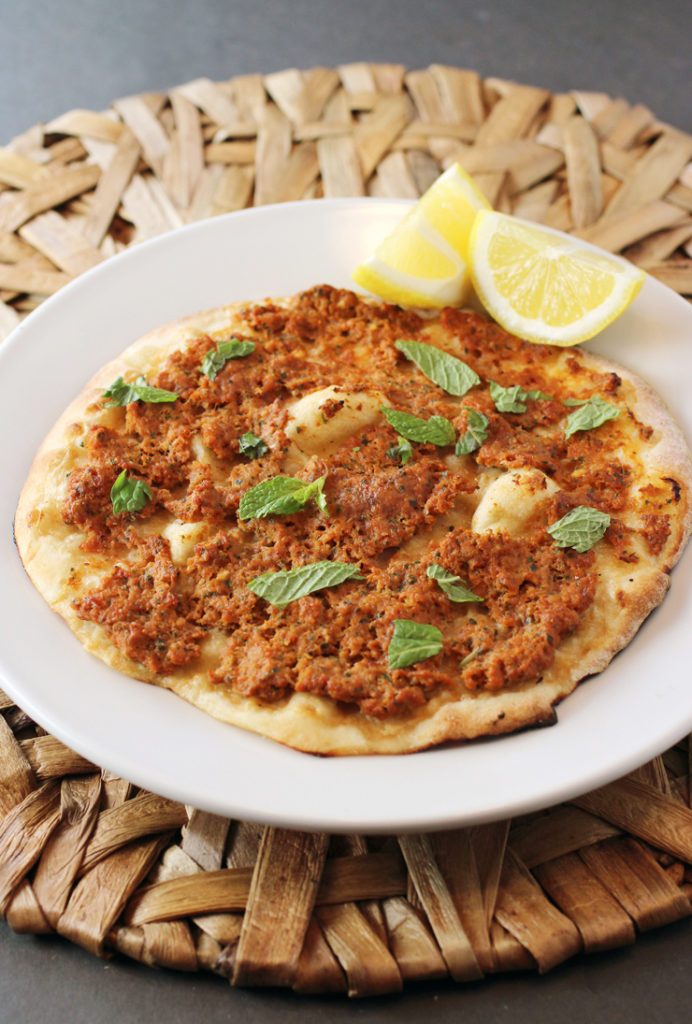
When California’s shelter-in-place mandate first went into effect during this pandemic, my husband peered into the fridge and cupboards with increasing anxiousness.
Like a good wife, I merely patted him on the shoulder reassuringly and said, “I got this.”
And I did.
As I told him, even if all we had was flour and water, we would still be fine. Because if bread is the staff of life, then flour is life, itself.
After all, that’s all you need to make some basic flat breads, sourdough, dumplings, pasta, and pancakes.
Throw in eggs and some oil, and you really have it made.
And of course, at this point, we still had plenty more than that.
That’s why I thought it the perfect time to try my hand at “Lahmajo,” otherwise known as Armenian pizza. I mean, how good does that sound, right?
It’s from the marvelous cookbook, “Lavash: The Bread That Launched 1,000 Meals, Plus Salads, Stews, and Other Recipes From Armenia” (Chronicle Books, 2019) by San Francisco cookbook author Kate Leahy, San Francisco photographer John Lee, and Los Angeles chef and recipe writer Ara Zada.
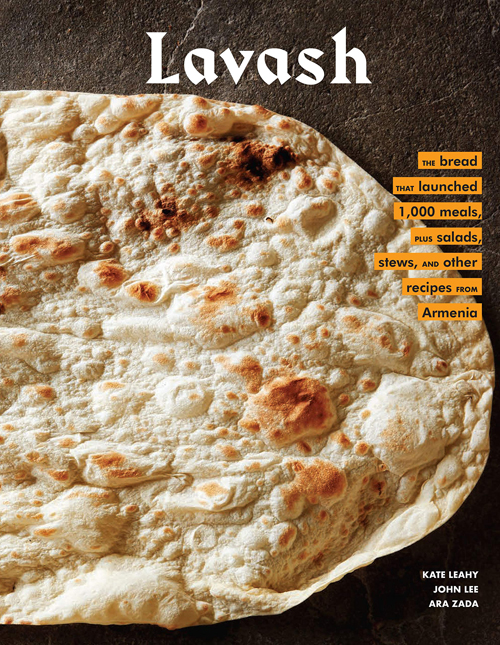
The book, of which I received a review copy, is the perfect escape now, too, because it transports you through words, photos and dishes to Armenia, a tiny country in the mountain Caucus region between Asia and Europe.
Leahy, Lee and Zada traveled there to learn about the soups, salads, celebratory dishes, and of course, breads that define this cuisine. They include “Matnakash (Bread Drawn by Fingers),” “Beef Tartare with Bulgur,” “Urfa Kebab (Skewers of Eggplant and Meatballs),” and “Apricots Preserved in Simple Syrup.”
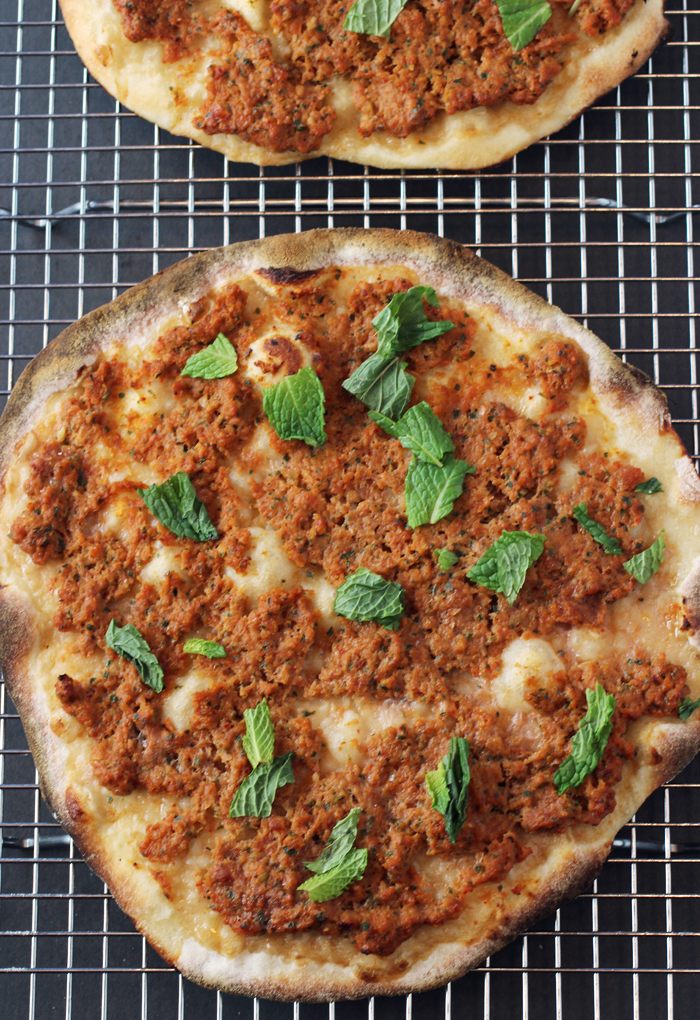
This Armenian pizza is a favorite the world over now. It starts with making old dough, which is just flour, water and yeast mixed together to ferment for a couple hours or overnight. Much like a sourdough starter, it’s then mixed with more flour and water, adding a more developed flavor to the resulting pizza.
Unlike pizza that you stretch with your fingers, you actually roll out these dough rounds with a rolling pin. It’s not a very sticky dough, so it’s a cinch to roll it quite thin, then transfer it without mishap to a pizza peel or large cutting board (if you don’t have a peel).
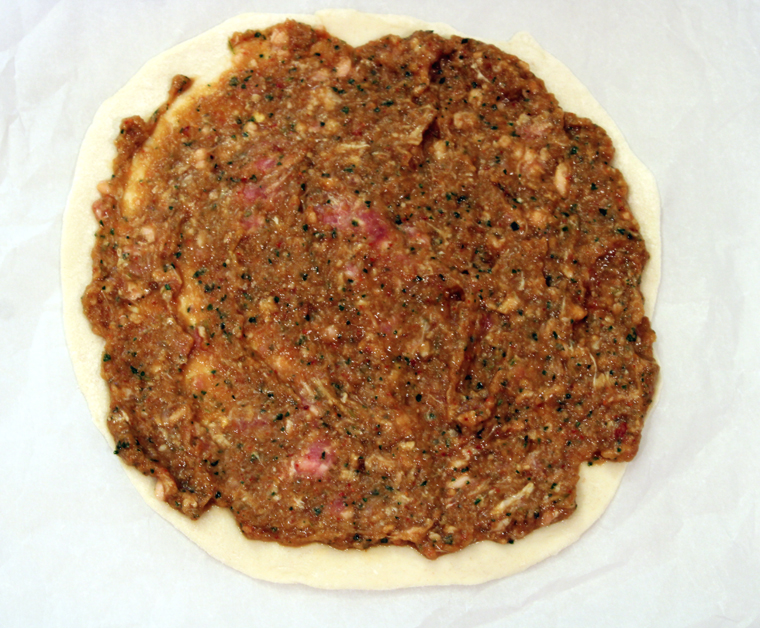
There’s no cheese on this pizza — but you won’t miss it. Instead, it’s slathered with a thick, concentrated mixture of ground lamb or beef (I used lamb) flavored with tomato paste, canned tomatoes, onion, parsley and garlic.
Each pizza takes all of 5 minutes to bake. I scrounged a few mint leaves from my backyard plant, and squirted on some fresh lemon juice before taking a bite. You can fold it up like a New York-slice to eat, if you like, too. Or just cut into wedges and dive in.
The crust is thin and crisp all over. The meaty topping is sweet, smoky, and faintly spicy. It’s like flatbread smeared with meat paste or, well, lamb jam. It’s an inspired taste of another place when we’ve all been cooped up in the same one for days.
Yes, this recipe does take some time to make — at least 6 hours if you make it in one go. Or because you can refrigerate the dough overnight at certain points, 3 days.
But time is something we all seem to have a lot of these days, whether we like it or not. Here’s a chance to use it not only constructively, but most deliciously.
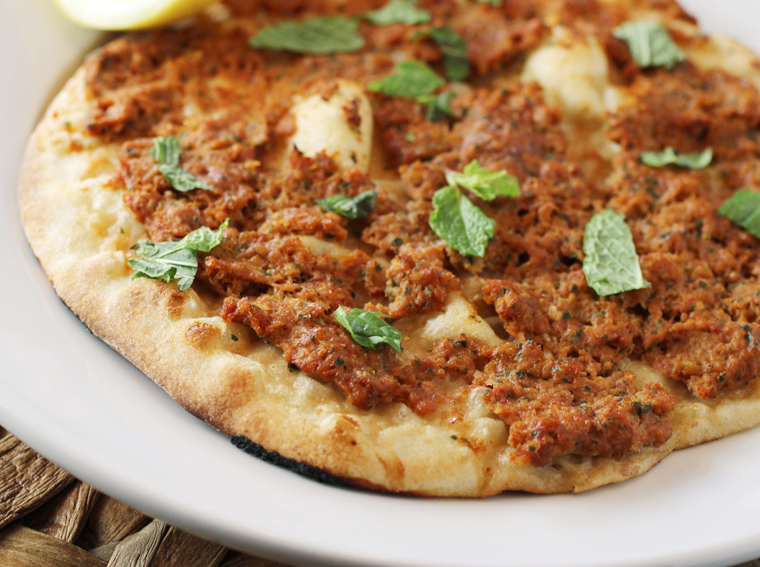
Lahmajo (Armenian Pizza)
(Makes 8)
Old dough:
1/2 cup all-purpose flour
1/4 cup plus a scant 1 tablespoon lukewarm water
1/4 teaspoon instant yeast
Lavash dough:
1 cup lukewarm water
1 tablespoon sunflower or other neutral oil
2 teaspoons kosher salt
3 cups plus 2 tablespoons all-purpose flour, plus more for dusting
Topping:
One 14.5-ounce can whole plum tomatoes
1 tablespoon tomato paste or red pepper paste
1/2 yellow onion, coarsely chopped
1/2 cup coarsely chopped flat-leaf parsley, including stems
4 garlic cloves, coarsely chopped
1 tablespoon sunflower oil or other neutral oil
1 tablespoon sweet paprika
1 1/2 teaspoons kosher salt
1/2 teaspoon ground cumin
1/2 teaspoon red pepper flakes
1 pound ground lamb or lean beef
Finely chopped mint leaves, for garnish (optional)
Lemon wedges, for serving
To make the old dough: Using your hands or a rubber spatula, squish together the flour, water, and yeast in a bowl until it forms a thick paste. Scrape the paste into a small, lightly oiled container, cover, and let it sit out for 1 1/2 to 2 hours, or refrigerate for at least 2 hours before using. When ready, the ball will have doubled in volume.
To make the dough: In the bowl of a stand mixer, combine the old dough, water, oil, and salt. Squish the old dough with your hands to break it up in the water; it doesn’t have to be perfectly mixed in.
Fit the stand mixer with the paddle attachment and add a third of the flour. Mix on low speed until the dough looks like pancake batter. Add the remaining flour and mix on low speed until incorporated. Remove the paddle attachment, pulling off any dough stuck to it. If there is flour at the base of the bowl, use your hands to press the dough into the flour. Cover the bowl with a kitchen towel and let the dough sit for 20 minutes to allow the flour to hydrate.
(To make by hand, combine the old dough, water, oil, and salt in a large bowl and mix together, squishing the old dough into the water with your hands. Stir in the flour gradually with your fingers until a crumbly dough forms, then knead it a few times in the bowl by folding the dough over itself and pressing it down into the bowl. Cover the bowl with a kitchen towel and let the dough rest for 20 minutes.)
Remove the towel and attach the dough hook to the stand mixer. Mix the dough on medium speed until the dough releases from the sides of the bowl without sticking and feels smooth to the touch, about 4 minutes. Turn the mixer off and reposition the dough to the center of the bowl if it seems to get stuck on one side of the bowl.
(To knead by hand, dust the counter lightly with flour and place the dough on top. Begin kneading by stretching and folding the dough over itself until it is smooth to the touch, 5 to 7 minutes.)
Lightly oil an 8-cup glass Pyrex or a large glass bowl and place the dough inside. Cover the bowl with a lid, a plate, or plastic wrap, and let it rest for 3 hours or until doubled in volume. Or refrigerate overnight and let the dough come to room temperature for at least 2 hours before portioning.
To portion and shape the dough, dust the counter lightly with flour and place the dough on top. Using a bench scraper or knife, cut the dough into eight pieces about 3.5 ounces each.
To shape the dough: Cup the palm of your hand over one portion at a time and move your hand in a circle. The friction from the counter will help form the dough into a ball. If there is too much flour on the surface and the dough is sliding around, give the counter a spritz of water and try again. Lightly oil a rimmed try and place the dough on the tray, ensuring that the portions are not touching. Cover with a kitchen towel or plastic wrap lightly coated with oil. Leave out for 1 to 1 1/2 hours, or until puffy, or refrigerate for up to 3 days. If you refrigerate the dough, use plastic wrap to cover it and expect it to take an hour or two to return to room temperature before it is ready to be rolled out.
Place a baking stone or baking steel in the center of the oven and preheat to 550 degrees or as high as it will go. Set out a couple half-sheet pans or platters to place the finished lahmajo on.
To make the topping: In a food processor or blender, pulse together the tomatoes, tomato paste, onion, parsley, garlic, oil, paprika, salt, cumin, and red pepper flakes. Place the meat in a bowl and pour the contents of the food processor over it. Using your hands, squish the tomato mixture into the meat until evenly incorporated. You will have about 4 cups of filling.
To shape the lahmajo: Lightly dust the counter with flour (the dough will not be that sticky). Place a ball of dough in the center and pat into a round. Using a rolling pin, roll the dough into a thin circle about 10 inches in diameter.
Slide a a sheet of parchment paper onto a pizza peel or a large cutting board and place the dough on top. Spread slightly less than 1/2 cup of the tomato-meat topping evenly over the surface of the dough.
To bake the lahmajo: In one quick motion, slide the parchment off the peel directly onto the pizza stone in the oven. Bake for 5 to 6 minutes, or until the edges are evenly browned and the meat is cooked through. While the first lahmajo bakes, start rolling out the dough for the second.
To take the lahmajo out of the oven: Slide the parchment paper onto the pizza peel or use a pair of tongs to pull the lahmajo and parchment paper onto a cutting board. If the topping looks wet but the parchment paper is getting too brown, remove the parchment paper and return the lahmajo to the oven for 1 to 2 more minutes until the topping is dry. Repeat with the remaining dough and topping, evenly dividing the topping among the dough portions.
Before serving, top with mint, if using. Offer lemon wedges at the table for seasoning. Once baked, extra lahmajo freeze well for up to 2 months and can be reheated in the oven at 400 degrees for about 8minutes, or until hot and crispy on the edges.
From “Lavash” by Kate Leahy, John Lee, and Ara Zada
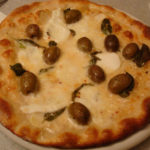
More Pizza to Make and Enjoy: A16’s Neapolitan-Style Pizza

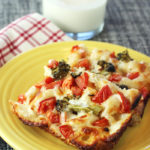
And: Lemon, Broccoli and Garlic Deep-Pan Pizza
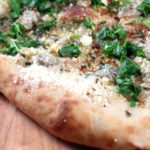

I have a copy of your cookbook.
Thank you for sharing your recipes.
Hi Siran: You’re very welcome! 😉
My Armenian Grandma was a master of all doughs! My Dad made a giant rolling pin so she could make lavash and baklava faster! Can’t wait to try your tecipe!
Hi Roseanne: How sweet of your dad to make that giant rolling pin for her. I bet that was a sight to see. This is actually Kate Leahy’s recipe from her cookbook. It’s a fine one, indeed. Enjoy! 😉